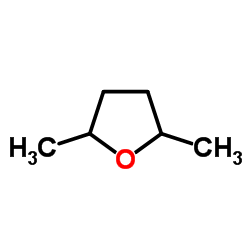Kinetics and thermochemistry of 2,5-dimethyltetrahydrofuran and related oxolanes: next next-generation biofuels.
John M Simmie
Index: J. Phys. Chem. A 116(18) , 4528-38, (2012)
Full Text: HTML
Abstract
The enthalpies of formation, entropies, specific heats at constant pressure, enthalpy functions, and all carbon-hydrogen and carbon-methyl bond dissociation energies have been computed using high-level methods for the cyclic ethers (oxolanes) tetrahydrofuran, 2-methyltetrahydrofuran, and 2,5-dimethyltetrahydrofuran. Barrier heights for hydrogen-abstraction reactions by hydrogen atoms and the methyl radical are also computed and shown to correlate with reaction energy change. The results show a pleasing consistency and considerably expands the available data for these important compounds. Abstraction by ȮH is accompanied by formation of both pre- and postreaction weakly bound complexes. The resulting radicals formed after abstraction undergo ring-opening reactions leading to readily recognizable intermediates, while competitive H-elimination reactions result in formation of dihydrofurans. Formation enthalpies of all 2,3- and 2,5-dihydrofurans and associated radicals are also reported. It is probable that the compounds at the center of this study will be relatively clean-burning biofuels, although formation of intermediate aldehydes might be problematic.
Related Compounds
| Structure | Name/CAS No. | Molecular Formula | Articles |
|---|---|---|---|
 |
2,5-DIMETHYLTETRAHYDROFURAN
CAS:1003-38-9 |
C6H12O |
|
Activation of transient receptor potential vanilloid 3 chann...
2015-06-01 [Endocrinology 156 , 2074-86, (2015)] |
|
The reverse of the 'repair' reaction of thiols: H-abstractio...
1987-01-01 [Int. J. Radiat. Biol. Relat. Stud. Phys. Chem. Med. 51(1) , 91-102, (1987)] |
|
One-step catalytic transformation of carbohydrates and cellu...
2010-05-25 [ChemSusChem 3(5) , 597-603, (2010)] |
|
Mechanistic study of a one-step catalytic conversion of fruc...
2012-09-24 [Chemistry 18(39) , 12363-71, (2012)] |
|
Independent generation and reactivity of 2-deoxy-5-methylene...
2000-07-28 [J. Org. Chem. 65(15) , 4648-54, (2000)] |